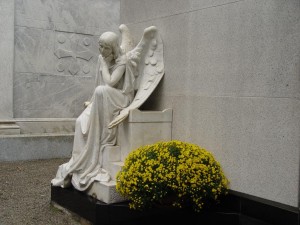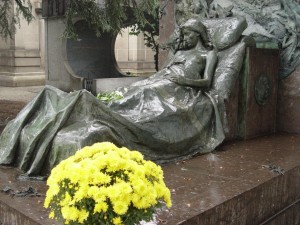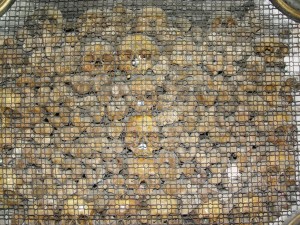
November starts with the ponte dei morti, which, literally translated, means the bridge of the dead. A horror movie? A natural disaster? No, just a long weekend, from Thursday 1 November 2012 to Sunday 4 November. Tutti i Santi, 1 November, is a public holiday in Italy. For many people, Friday gets thrown in free to bridge the gap. Then on Wednesday 2 November, there is the Commemorazione dei Defunti, which is not a holiday, but a day when many people visit cemeteries and put flowers on their family graves. For this reason, November is an excellent time in which to visit Milan’s Cimitero Monumentale, which is always spectacular, and even better when bedecked with crysanthemums and other blooms. Though externally it is obstructed by a building site for a new Metro line, access is still possible.
Cemetery visiting, in the sightseeing sense, is not really an Italian thing at all. Most Italian males, when faced with this sort of suggestion, would surreptitiously touch a certain dual part of their anatomy, and many Italian females would extend the second and fifth fingers of one or both hands in the unmistakable “horns” gesture that keeps calamity and death at an acceptable distance. But for many visitors from abroad, a visit to one of Italy’s monumental cemeteries is an essential part of a trip here.

Probably the finest of all is Milan’s Monumentale, with Genoa’s Staglieno and Turin’s Monumentale close behind. Milan’s cemetery was built from 1866, on the wave of the “cemetery movement” that really started with Père Lachaise in Paris and spread all over Europe. After the Edict of St. Cloud had prohibited burial in churches, the time was ripe for the cimitero monumentale, an enclosed field in which there were no problems of space. Above all, this type of cemetery was a civic establishment, only partially controlled by the clerical authorities, and this meant that artists could indulge in extreme realism and images that would never be allowed in a church. In addition, Milan’s cemetery developed in the years during which the Romantic movement was at its height. For Romantic artists and writers, the concept of death was no longer associated with fear and horror, but with release, repose, rebirth, and even ecstasy of the most explicit variety. And so many of the tombs feature extraordinarily beautiful sculptures of lightly veiled, or totally naked, women. The cemetery is a huge – 250,000 square metres – open-air gallery, with over 6,000 pieces of sculpture in peaceful and green surroundings. It’s open from 8.30 to 17.30 every day except Monday.
There is lots more religious sculpture in the Cathedral, just opposite Palazzo Reale, where you can see a sculptural version of Saint Bartholomew post-martyrdom. This, just inside the entrance on the south side, is definitely not for the faint-hearted. The 16th-century sculptor Marco d’Agrate shows a
man whose skin has just been totally removed, and takes the opportunity to show off his skill at muscles, veins and tendons, which at that time was all the rage after Leonardo da Vinci’s pioneering anatomy studies.

Not far off, in Piazza Santo Stefano, there is one of the strangest sights in Milan. The largest church is Santo Stefano, and the church tower used to be on the left-hand side of the church. When it collapsed in 1642, it fell on top of a much smaller church, San Bernardino, nearby, which for centuries had been used to store human remains. And so San Bernardino was rebuilt, and the bones were used as an interior decoration material. The writing is on the wall, as one says, and in this case the writing is in femurs. To find this little chapel, look for the passage on the right after going in. The main church was built in the 1700s after the bone-lined chapel had become something of an attraction for the people of the city. San Bernardino is open from Monday to Saturday mornings (about 8.30 to 12.30) and it also opens for Mass on Sunday.
After all this culture, what about a little refreshment? Personally, at this time of year I can’t resist pane dei morti, little chocolatey cakes sprinkled with sugar, in all the pasticcerie. Delicious. And, to conclude, neither can I resist a couple of quotations on the subject. “Dying is a very dull, dreary affair. And my advice to you is to have nothing whatever to do with it”. (W. Somerset Maugham). “I am ready to meet my Maker. Whether my Maker is prepared for the great ordeal of meeting me is another matter”. (Winston Churchill). But my absolute favourite is not by a famous person at all, but by one of my ancestors. I have recently discovered that my great-grandfather Henry, when aged 84, wrote, in a letter to his local newspaper: “… and I do not expect to stop smoking until my cremation is over”. Actually my second favourite is also by the same venerable Henry who, having admitted to his partiality for beer, wrote, “When asked ‘Is life worth living?’ I reply that it depends on the liver!” Brilliant! Now why couldn’t I think of something like that? Unless he stole it from someone else, of course.
© Henry Neuteboom 2012
